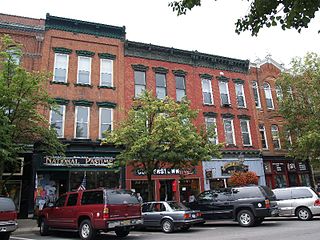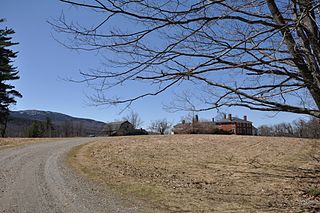Clark Cottage may refer to:
- Clark Cottage, New Zealand, a historic cottage located in Hobsonville, Auckland
- Clark Cottage, Scotland, a historic cottage located in Port Charlotte on the island of Islay
Clark Cottage may refer to:

Cooperstown is a village in and the county seat of Otsego County, New York, United States. Most of the village lies within the town of Otsego, but some of the eastern part is in the town of Middlefield. Located at the foot of Otsego Lake in the Central New York Region, Cooperstown is approximately 60 miles west of Albany, 67 mi (108 km) southeast of Syracuse and 145 mi (233 km) northwest of New York City. The population of the village was 1,794 as of the 2020 census.

Moreau is a town in Saratoga County, New York, United States. The population was 16,202 at the 2020 census. The town is located in the northeast part of the county, north of Saratoga Springs. Moreau is named after Jean Victor Moreau, a French general, who visited the area just before the town was formed. The town contains a village called South Glens Falls.

Saranac Lake is a village in the state of New York, United States. As of the 2020 census, the population was 4,887, making it the largest community by population in the Adirondack Park. The village is named after Upper, Middle and Lower Saranac lakes, which are nearby.

Elijah Clark State Park is a 447-acre (1.81 km2) Georgia state park located in Lincolnton, on the western shore of Lake Strom Thurmond. The park is named for Elijah Clarke, a frontiersman and war hero who led a force of pioneers in Georgia during the American Revolution. A reconstructed log cabin displays colonial life with furniture and tools dating back to 1780. The park is also the site of the graves of Clark and his wife, Hannah. The park's location on the lake makes it popular with fishermen.

Point Clark is a lakefront cottage community on Lake Huron, in the municipality of Huron-Kinloss, Ontario, Canada. It is approximately 15 kilometres south of Kincardine and 40 kilometres north of Goderich. Main streets include Huron Road and Lake Range Road. Point Clark is served by Highway 21 (Ontario). It is a cottage town, and has a rare Imperial Tower style lighthouse. There is a sandy beach and a small harbour with a boat ramp. There are two streams or rivers that run into Lake Huron around Point Clark: Clark Creek and Pine River. There is a separate harbour in the mouth of the Pine River. Amberley is just outside and to the south of Point Clark and Lucknow is to the south-east of Point Clark.

The Seth Peterson Cottage is a two-room lakeside cottage located in Mirror Lake State Park outside Lake Delton, Wisconsin, United States. It was designed by Frank Lloyd Wright in 1958.

Grant Cottage State Historic Site is an Adirondack mountain cottage on the slope of Mount McGregor in the town of Moreau, New York. Ulysses S. Grant, the 18th President of the United States, died of throat cancer at the cottage on July 23, 1885. The house was maintained as a shrine to U.S. Grant following his death by the Mount McGregor Memorial Association and a series of live-in caretakers. The building became a New York State Historic Site in 1957 and was added to the National Register of Historic Places in 1971. The Historic Site was designated a National Historic Landmark by the National Park Service in 2021.

Harrisville Historic District is a well-preserved historic New England mill village located in the southwest part of New Hampshire. It consists of about 200 acres (0.81 km2) and about 135 structures. It was declared a National Historic Landmark in 1977.

The Railroad Cottage Historic District is an area originally comprising eight historic cottages along Casino Center Boulevard in downtown Las Vegas, Nevada. The eight cottages had once been part of a development of 64 homes constructed by the San Pedro, Los Angeles & Salt Lake Railroad to provide housing for their employees. Although a handful of cottages still existed at the time, only eight neighboring cottages were included in the district when it was created in 1987.

The Edgar Allan Poe Cottage is the former home of American writer Edgar Allan Poe. It is located on Kingsbridge Road and the Grand Concourse in the Fordham neighborhood of the Bronx, New York, a short distance from its original location, and is now in the northern part of Poe Park.

Point Clark Lighthouse is located on in a beach community, Point Clark, Ontario, near a point that protrudes into Lake Huron. Built between 1855 and 1859 under the instructions of the Board of Works, Canada West, it is one of the few on the Great Lakes to be made primarily from stone. It is one of the Imperial Towers, a group of six nearly identical towers built by contractor John Brown for the "Province of Canada" on Lake Huron and Georgian Bay, all completed by 1859. The location for the Point Clark lighthouse was selected to warn sailors of the shoals (sandbars) 2 miles (3.2 km) off the Lake Huron coast. It is still functioning as an automated light. A restoration that eventually exceeded $2.3 million started in 2011 and the facility reopened for tourism in June 2015.
Witherspoon may refer to:

Peyton Clark Cottage, also known as "Woodthorpe," is a historic cure cottage located at Saranac Lake, town of St. Armand in Essex County, New York. It was built in 1915 and is a 2+1⁄2-story rectangular structure with stucco siding and a gable roof and trimmed with green wood in the Tudor Revival style. It features two over/under cure porches running along the entire south side. A 1971 fire destroyed five bedrooms and the roof.

The Johns Hotel (20IR64) is a complex of buildings, of which but two remain, located near Washington Harbor, on Barnum Island, Isle Royale National Park, Michigan. It was listed on the National Register of Historic Places in 1997.
The La Jolla Historical Society is a private 501(c)(3) nonprofit organization in the La Jolla community of San Diego, California. According to its mission statement, it "celebrates the history and culture of this region along the water's edge through interdisciplinary programs, exhibitions, and research that challenge expectations. It balances contemporary and historic perspectives to create understanding and connection."

The Cottage Home Historic District is a historic district and neighborhood located on the near east side of Indianapolis, Indiana. A small portion of Cottage Home is listed on the National Register of Historic Places while a larger area is listed on the state and local levels. Known for its preponderance of "cottage-style" homes built with strong Victorian influences, Cottage Home has historically been a working class neighborhood. Numerous industrial buildings are also scattered throughout the district, providing a base of economic activity. Today, however, many of these buildings are vacant, providing a special challenge to preservation and urban renewal efforts.

The Eli Morse Farm is a historic farm on Lake Road in Dublin, New Hampshire. It is one of the earliest settlements in the town, settled by Eli Morse in 1764, and has been in the hands of just two families. Its transformation to summer resort use was one of the first in the Dublin Pond area. The farm was listed on the National Register of Historic Places in 1983.
Clark Cottage is a residential building in the Scottish village of Port Charlotte on the island of Islay. The building is on the eastern side of Main Street in the south-eastern part of the town. On 28 August 1980, Clark Cottage was listed as a Category C Listed Building.

The Ruvaal, Rhuvaal, or Rubh'a' Mhàil Lighthouse is a listed 19th-century lighthouse located at the north-eastern end of the island of Islay, in the Inner Hebrides off the west coast of Scotland. The active lighthouse marks the northern approaches to the Sound of Islay, a narrow channel separating Islay from the adjacent island of Jura, and is one of the seven lighthouses operated by the Northern Lighthouse Board, which act as maritime aids to navigation on and around Islay.

The Clark Lake Community Center is a public community center located at 3740 Ocean Beach Road in Clark Lake, Michigan. It was originally built as a private house at a different location, and was moved to the present location in 1998. It was listed on the National Register of Historic Places in 1994.